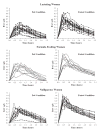Lactational state modifies alcohol pharmacokinetics in women
- PMID: 17433009
- PMCID: PMC2265592
- DOI: 10.1111/j.1530-0277.2007.00387.x
Lactational state modifies alcohol pharmacokinetics in women
Abstract
Background: Given the physiological adaptations of the digestive system during lactation, the present study tested the hypothesis that lactation alters alcohol pharmacokinetics.
Methods: Lactating women who were exclusively breastfeeding a 2- to 5-month-old infant and 2 control groups of nonlactating women were studied. The first control group consisted of women who were exclusively formula-feeding similarly aged infants, whereas the other consisted of women who had never given birth. A within-subjects design study was conducted such that women drank a 0.4 g/kg dose of alcohol following a 12-hour overnight fast during one test session (fasted condition) or 60 minutes after consuming a standard breakfast during the other (fed condition). Blood alcohol concentration (BAC) levels and mood states were obtained at fixed intervals before and after alcohol consumption.
Results: Under both conditions, the resultant BAC levels at each time point were significantly lower and the area under the blood alcohol time curve were significantly smaller in lactating women when compared with the 2 groups of nonlactating women. That such changes were due to lactation per se and not due to recent parturient events was suggested by the finding that alcohol pharmacokinetics of nonlactating mothers, who were tested at a similar time postpartum, were no different from women who had never given birth. Despite lower BAC levels in lactating mothers, there were no significant differences among the 3 groups of women in the stimulant effects of alcohol. However, lactating women did differ in the sedative effects of alcohol when compared with nulliparous but not formula-feeding mothers. That is, both groups of parous women felt sedated for shorter periods of time when compared with nulliparous women.
Conclusions: The systemic availability of alcohol was diminished during lactation. However, the reduced availability of alcohol in lactating women did not result in corresponding changes in the subjective effects of alcohol.
Figures



Similar articles
-
Breast pumping and lactational state exert differential effects on ethanol pharmacokinetics.Alcohol. 2010 Mar;44(2):141-8. doi: 10.1016/j.alcohol.2009.10.011. Epub 2010 Jan 6. Alcohol. 2010. PMID: 20056373 Free PMC article. Clinical Trial.
-
Biphasic effects of moderate drinking on prolactin during lactation.Alcohol Clin Exp Res. 2008 Nov;32(11):1899-908. doi: 10.1111/j.1530-0277.2008.00774.x. Epub 2008 Aug 18. Alcohol Clin Exp Res. 2008. PMID: 18715274 Free PMC article. Clinical Trial.
-
Effect of high-fat, high-protein, and high-carbohydrate meals on the pharmacokinetics of a small dose of ethanol.Br J Clin Pharmacol. 1997 Dec;44(6):521-6. doi: 10.1046/j.1365-2125.1997.t01-1-00620.x. Br J Clin Pharmacol. 1997. PMID: 9431825 Free PMC article. Clinical Trial.
-
Alcohol and breastfeeding.Basic Clin Pharmacol Toxicol. 2014 Feb;114(2):168-73. doi: 10.1111/bcpt.12149. Epub 2013 Nov 7. Basic Clin Pharmacol Toxicol. 2014. PMID: 24118767 Review.
-
Evidence-based survey of the elimination rates of ethanol from blood with applications in forensic casework.Forensic Sci Int. 2010 Jul 15;200(1-3):1-20. doi: 10.1016/j.forsciint.2010.02.021. Epub 2010 Mar 20. Forensic Sci Int. 2010. PMID: 20304569 Review.
Cited by
-
Population pharmacokinetics of artesunate and dihydroartemisinin in pregnant and non-pregnant women with malaria.Malar J. 2011 May 8;10:114. doi: 10.1186/1475-2875-10-114. Malar J. 2011. PMID: 21548983 Free PMC article. Clinical Trial.
-
Breastfeeding and prolactin levels in lactating women with a family history of alcoholism.Pediatrics. 2010 May;125(5):e1162-70. doi: 10.1542/peds.2009-3040. Epub 2010 Apr 19. Pediatrics. 2010. PMID: 20403941 Free PMC article. Clinical Trial.
-
Alcohol sensitivity in women after undergoing bariatric surgery: a cross-sectional study.Surg Obes Relat Dis. 2020 Apr;16(4):536-544. doi: 10.1016/j.soard.2020.01.014. Epub 2020 Jan 23. Surg Obes Relat Dis. 2020. PMID: 32075778 Free PMC article.
-
Recent advances in alcohol metabolism: from the gut to the brain.Physiol Rev. 2025 Oct 1;105(4):2501-2535. doi: 10.1152/physrev.00053.2024. Epub 2025 Jul 10. Physiol Rev. 2025. PMID: 40637545 Free PMC article. Review.
-
Recommendations for the establishment and operation of a donor human milk bank.Nutr Rev. 2023 Mar 9;81(Suppl 1):1-28. doi: 10.1093/nutrit/nuad012. Nutr Rev. 2023. PMID: 36892193 Free PMC article.
References
-
- Abel EL, Greizerstein HB, Siemens AJ. Influence of lactation on rate of disappearance of ethanol in the rat. Neurobehav Toxicol. 1979;1:185–186. - PubMed
-
- Badger TM, Hidestrand M, Shankar K, McGuinn WD, Ronis MJ. The effects of pregnancy on ethanol clearance. Life Sci. 2005;77:2111–2126. - PubMed
-
- Baraona E. Site and quantitative importance of alcohol first-pass metabolism. Alcohol Clin Exp Res. 2000;24:405–406. - PubMed
-
- Baraona E, Abittan CS, Dohmen K, Moretti M, Pozzato G, Chayes ZW, Schaefer C, Lieber CS. Gender differences in pharmacokinetics of alcohol. Alcohol Clin Exp Res. 2001;25:502–507. - PubMed
Publication types
MeSH terms
Substances
Grants and funding
LinkOut - more resources
Full Text Sources

